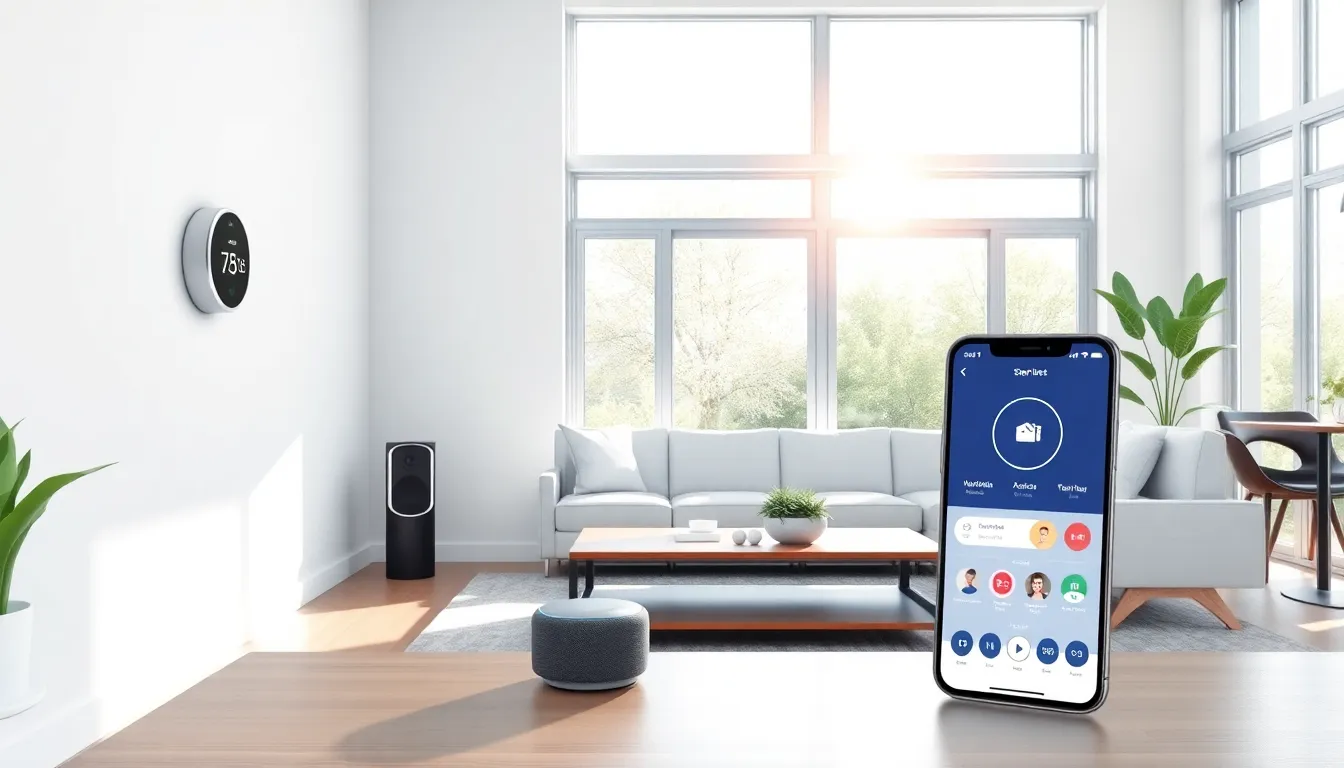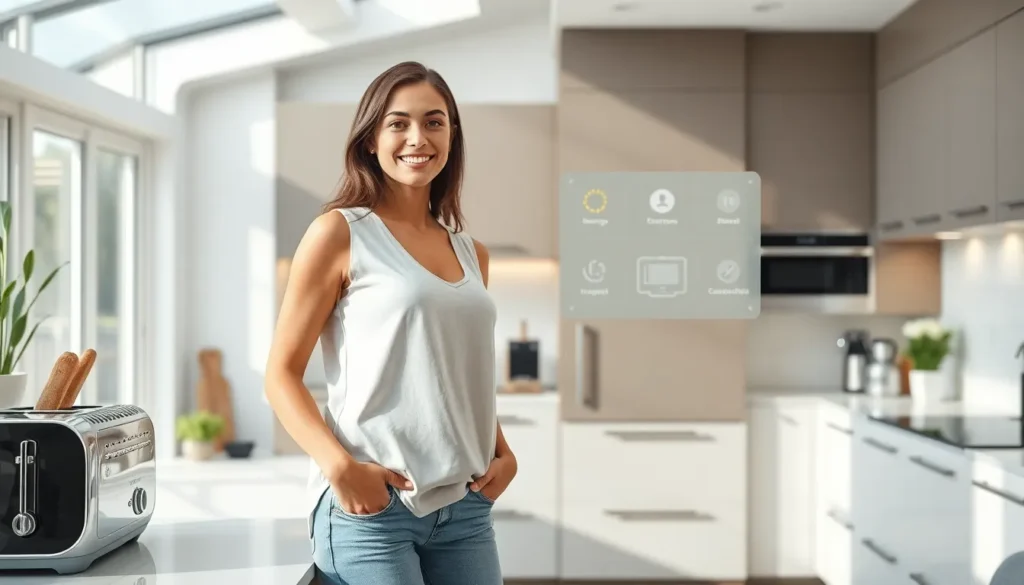Table of Contents
ToggleImagine a world where your toaster knows exactly how you like your bread—golden brown, not burnt to a crisp. The future of smart homes is just around the corner, and it’s poised to transform everyday living into something straight out of a sci-fi movie. With a flick of a finger or a simple voice command, homes will soon cater to our whims like a personal butler who never forgets to ask if you want your coffee black or with a splash of oat milk.
Future of Smart Homes: An Overview
Smart homes are transforming daily life with emerging technologies. Appliances will learn individual habits and preferences, ensuring tailored experiences for every user. Devices will communicate seamlessly, creating a network of interconnected solutions that enhance comfort and efficiency.
Voice commands will simplify interactions with home systems. Users can adjust lighting, temperature, and security settings effortlessly. Gesture controls are becoming increasingly intuitive, allowing operations with simple hand movements.
Home security will gain sophistication with advanced monitoring systems. Cameras will use AI algorithms to distinguish between familiar faces and intruders. Alerts will be sent instantly to homeowners’ smartphones when unusual activity occurs.
Energy management will improve with smart meters and automated systems. These tools will optimize energy consumption by analyzing usage patterns. Renewable energy sources, like solar panels, will integrate into home systems, promoting sustainability.
Healthcare monitoring will play a significant role in future smart homes. Wearable technologies will sync with home systems to track health metrics and provide notifications to caregivers. This integration will enhance safety for seniors and individuals with health concerns.
Entertainment experiences will evolve as well. Smart TVs and sound systems will curate content based on user preferences, transforming how families enjoy media. Integration of virtual reality and augmented reality will create immersive home environments.
In this way, the future of smart homes is characterized by increased convenience, efficiency, and safety. Devices will work together to enhance quality of life, making homes not only smarter but also more responsive to the needs of their inhabitants.
Emerging Technologies in Smart Homes

Smart homes continually evolve, driven by advancements in technology. These changes enhance convenience, efficiency, and safety, ultimately transforming daily life.
Internet of Things (IoT) Enhancements
IoT technologies create interconnected devices that communicate seamlessly. Appliances learn user habits and preferences, resulting in a tailored experience. Smart thermostats, for instance, adjust temperatures based on individual routines. Homeowners control systems remotely through smartphones or voice commands. Improved connectivity minimizes energy consumption, optimizing overall efficiency. Smart locks enhance security by allowing homeowners to monitor access in real-time. Furthermore, utilities benefit from data collected, leading to better energy management and lower costs for consumers.
Artificial Intelligence Innovations
AI brings significant advancements to smart homes, offering personalized experiences. Voice assistants process commands more efficiently, allowing for more fluid communication. Predictive algorithms analyze user behavior, improving device responses accordingly. For example, smart fridges track food inventory, suggesting recipes based on available ingredients. Advanced security systems recognize familiar faces, instantly notifying homeowners of any unusual activity. Health monitoring devices alert caregivers about seniors’ metrics, improving safety and care. Enhanced entertainment systems curate content based on preferences, enriching overall user experiences.
Benefits of Smart Homes
Smart homes offer significant advantages, transforming lifestyles through technology. Enhanced convenience and comfort arrive through interconnected devices that respond to individual needs.
Energy Efficiency and Sustainability
Energy efficiency improves with smart homes. Smart meters analyze consumption patterns, helping to minimize electricity waste. For example, smart thermostats adjust heating and cooling based on occupancy, resulting in lower energy bills. Homeowners benefit from automated lighting systems that turn off when no one is in the room. Integrating solar panels with smart systems promotes sustainability, allowing homeowners to track energy production and usage in real time. As a result, smart homes significantly reduce environmental impact while enhancing efficiency.
Enhanced Security Features
Enhanced security features elevate peace of mind for homeowners. Smart security cameras use AI to detect familiar faces and alert users about unfamiliar individuals. Additionally, smart locks facilitate real-time access monitoring, enabling remote management of entry points. Motion sensors trigger alerts when unusual activity occurs, keeping homeowners informed. The integration of these technologies provides layered security, ensuring safety at home. Smart security systems not only protect properties but also contribute to an overall feeling of safety for families.
Challenges Facing the Smart Home Industry
Smart home technology brings significant challenges that impact its growth and user adoption. Key concerns revolve around privacy, security, and integration compatibility among devices.
Privacy and Security Concerns
Privacy and security represent major obstacles for smart home technology. Data breaches expose sensitive information, raising fears about unauthorized access to personal data. Many users worry about how their information will be used and shared. Encryption standards play a critical role; inadequate protections can lead to vulnerabilities. As smart devices collect extensive user data, transparency in data handling becomes essential for building trust. Additionally, manufacturers must prioritize user consent regarding data usage, thereby ensuring a secure environment for consumers.
Integration and Compatibility Issues
Integration and compatibility pose substantial challenges in the smart home industry. Many devices run on different platforms, limiting the ability to create a cohesive user experience. Brands often utilize proprietary technologies, making it difficult for consumers to connect all their devices seamlessly. Achieving uniformity across devices would streamline interactions, but varying protocols hinder this progress. Successful integration requires industry-wide collaboration among manufacturers. A focus on fostering open systems can promote device interoperability, ultimately enhancing user satisfaction and experience.
Trends Shaping the Future of Smart Homes
Innovations continue to redefine smart home technology, pushing the boundaries of convenience, efficiency, and user experience. Key trends are emerging to shape this future landscape.
Voice Activation and Control
Voice activation enhances user interactions within smart homes. Users command devices with simple voice commands, creating a more intuitive experience. Natural language processing advances streamline communication, allowing devices to understand nuances in requests. Features like multi-language support cater to a diverse user base, expanding accessibility. Users gain the ability to control lighting, appliances, and security systems hands-free, significantly improving convenience. Shift in focus from manual controls to voice interfaces enhances accessibility for seniors and individuals with disabilities as well. Instant responses to commands foster seamless interactions.
Smart Appliances and Devices
Smart appliances evolve to meet users’ needs, integrating advanced technology into everyday tasks. Refrigerators offer inventory management, tracking items within and suggesting recipes based on available ingredients, and washing machines learn optimal cycles, saving both time and energy. Energy-efficient features resonate with environmentally conscious consumers, promoting sustainability. Communication between devices enables automation, where one appliance triggers actions in another, such as lights dimming when a movie starts. Multiple devices share data, enhancing tailored experiences and improving comfort levels. As these appliances continue to learn from users’ habits, they become more efficient and user-friendly, further solidifying their role in modern homes.
The future of smart homes promises a remarkable transformation in how individuals interact with their living spaces. As technology advances, homes will become more intuitive and responsive to personal needs. This evolution will not only enhance daily convenience but also promote energy efficiency and security.
With seamless device communication and advanced AI capabilities, smart homes will cater to unique preferences while ensuring safety and sustainability. The integration of innovative features will redefine user experiences, making homes more comfortable and efficient.
As challenges like privacy and compatibility are addressed, the vision of a fully connected and intelligent home will become a reality, ultimately improving the quality of life for all inhabitants.




